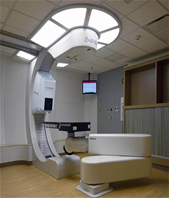Therapy Physics
Generally involves high radiation doses administered locally within the body to treat the cancer. The department uses modern equipment of radiation delivery and treatment planning.
Mevion S250 Proton Therapy System
– Pencil Beam Scanning, IMPT
– First patient was treated
January 14th, 2019
– 2nd center to treat patients in the U.S.
– Upgraded from a double scattering system
– RayStation treatment planning software
4 Linear Accelerators
–1 TrueBeam Novalis STX with HD MLCs
–1 Varian Trilogy
–2 Varian 2100EXs (one with OBI upgrade)
Varian Eclipse treatment planning software, BrainLab's iPlan for SBRT
~80 – 110 patients treated per day
HDR Brachytherapy
–Elekta (Nucletron) microSelectron v3
–Oncentra treatment planning system
– ~10 – 15 patients per week: interstitials, cylinders, T&R & Venezia
LDR Brachytherapy
–Eye Plaque: ~40-50 per year, I-125 with COMS/Eye Physics plaques
- Varian BrachyVision / Eye Physics treatment planning system
•Varian VariSeed LDR Planning System for Prostate Implant Radiotherapy
–Prostate Seeds: ~ 2-3 per year
• Total Body/Skin Irradiation
– ~ 5-10 patients per year
Gamma Knife
– Leksell Gamma Knife Perfexion
– ~100 patients per year
– Located in OU Medical Center

